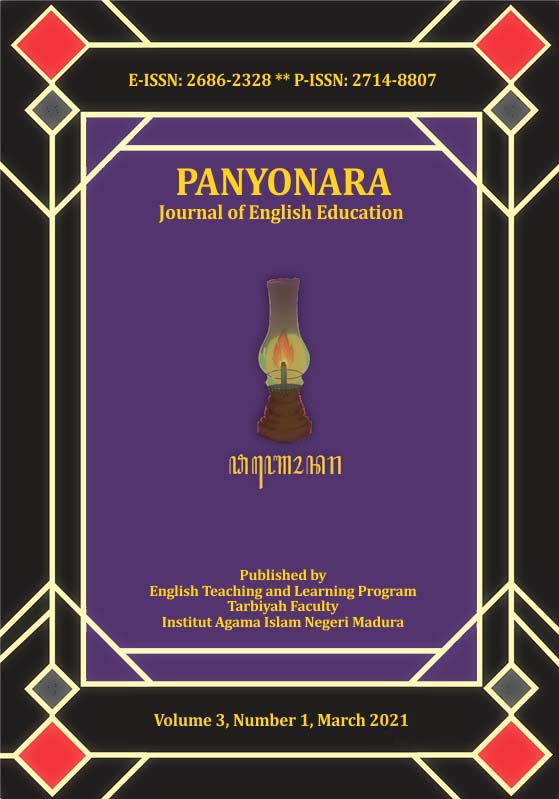Google Translate on Grab Application: Translation Study
 Abstract views: 488
,
Abstract views: 488
,
 PDF downloads: 337
PDF downloads: 337
Abstract
The Google Translate service is widely used in Indonesia because it is considered very helpful, including being used by the Grab application platform, which the public has increasingly used in recent years. This research focused on the study of translation used in conversations between drivers and consumers. There were indeed many kinds of research on translation, but not many have discussed the translation used on Grab platforms. This research aimed to describe some of the translation styles used and deemed necessary for Grab and Google Translate improvement. Researchers used a qualitative approach by presenting data in the form of descriptions and analysis. Several points were found to be improved in the process of translating sentences in the grab application, including omitting the translation into the target language, word by word translation, inconsistency in translating a term, the application was unable to detect abbreviations, so it was not translated, the interrogative sentence in the source language was translated into a statement sentence in the target language. This research had many limitations so that other researchers can develop it more widely in the future.
Downloads
References
Beeby, A. (2004). The Competencies Required by the Translator’s Roles as a Professional. Philadelphia: John Benjamins Publishing Company.
Catford, J. C. (1974). A Linguistik Theory of Translation. New York: Oxford University Press.
eks. (2019). Cuitan Kocak Netizen Soal Terjemahan “Ngaco” Grab. Retrieved March 25, 2021, from Teknologi website: https://www.cnnindonesia.com/teknologi/20190508171949-192-393136/cuitan-kocak-netizen-soal-terjemahan-ngaco-grab
Haq, Z. (2017). Penerjemahan Subtitle dari Bahasa Inggris ke dalam Bahasa Indonesia (Penelitian Analisis Isi pada Subtitle Film Contraband). DEIKSIS, 9(01), 100–108. doi: 10.30998/deiksis.v9i01.931
Hidayati, N. N. (2020). Rethinking The Quality of Children’s Bilingual Story Books. AL-ASASIYYA: Journal of Basic Education, 4(1), 46–60. doi: 10.24269/ajbe.v4i1.2226
Hoed, B. H. (2006). Penerjemahan dan Kebudayaan. Jakarta: Pustaka Jaya.
Jumiaty, A. A. (2019). N Products from English Text into Indonesian Language. Klasikal: Journal of Education, Language Teaching and Science, 1(1), 48–54. doi: 10.52208/klasikal.v1i1.10
Khair, S., Suwarno, B., & Arono, A. (2018). Translation Analysis of Student’s Work (Study of Poetry Translation). JOALL (Journal of Applied Linguistics and Literature), 3(2), 119–140. doi: 10.33369/joall.v3i2.6862
Kusumayanthi, S., & Fitria, T. (2020). An Analysis of Translation Method Used by College Students in Translating An Article. English Journal Literacy Utama, 4(1), 168–178. doi: 10.33197/ejlutama.vol4.iss1.2020.388
Larson, M. L. (1998). Meaning-based Translation. Lanham: University Press of America.
Miles, M. B., Huberman, A. M., & Saldaña, J. (2014). Qualitative Data Analysis: A Methods Sourcebook (3rd ed.). Thousand Oaks, Califorinia: SAGE Publications, Inc.
Moentaha, & Salihen. (2008). Bahasa dan Terjemahan. Jakarta: Kesaint Blanc.
Newmark, P. (1981). Approach to Translation. Oxford: Pergemon Press.
Newmark, P. (1988). A Textbook of Translation. Hertforshire: Prentice Hall International.
Nida, E. A., & Taber, C. R. (2003). The Theory and Practice of Translation. Leiden: E. J. Brill.
Purwaningsih, D. (2016). Comparing Translation Produced by Google Translation Tool to Translation Produced by Translator. Journal of English Language Studies, 1(1), 1–9. doi: 10.30870/jels.v1i1.678
Rahman, A. F. (2017). Indonesia Masuk 10 Negara Paling Hobi Google Translate. Retrieved March 25, 2021, from Detikinet website: https://inet.detik.com/cyberlife/d-3485785/indonesia-masuk-10-negara-paling-hobi-google-translate
Rahmannia, M., & Triyono, S. (2019). A Study of Google Translate Translations: An Error Analysis of Indonesian -to-English Texts. International Journal of Linguistics, Literature and Translation, 2(3), 290306. doi: 10.32996/ijllt.2019.2.3.22
Suara.com. (2020, February 28). Google Translate Tambah Lima Bahasa Baru. Retrieved March 25, 2021, from Suara.com website: https://www.suara.com/tekno/2020/02/28/070000/google-translate-tambah-lima-bahasa-baru
Sudana, P. A. P. (2014). Analisis Penerjemahan Istilah Budaya pada Novel Negeri 5 Menara ke dalam Bahasa Inggris: Kajian Deskriptif Berorientasi Teori Newmark. Jurnal Ilmu Sosial dan Humaniora, 3(2), 11.
The journal uses an Open Access policy under a Creative Commons Attribution-NonCommercial 4.0 International License. Authors who publish with this journal agree to the following terms:
- Authors retain copyright and grant the journal right of first publication with the work simultaneously licensed under a Creative Commons Attribution License that allows others to share the work with an acknowledgment of the work's authorship and initial publication in this journal.
- Authors are able to enter into separate, additional contractual arrangements for the non-exclusive distribution of the journal's published version of the work (e.g., post it to an institutional repository or publish it in a book), with an acknowledgment of its initial publication in this journal.
- Authors are permitted and encouraged to post their work online (e.g., in institutional repositories or on their website) prior to and during the submission process, as it can lead to productive exchanges, as well as earlier and greater citation of published work.
















